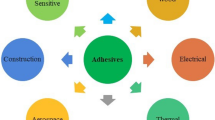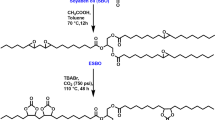Abstract
This paper reports a stable superhydrophobic surface on resin composites through the coprecipitation process of hydroxyethyl cellulose and modified Zn-particles, subsequently with the use of PDMS seal. Surface morphologies and chemical compositions are investigated with SEM, EDS, and FT-IR. As expected, the prepared surface has the water repellency with the contact angle of 153° and the sliding angle of 1°, respectively. According to the comparison of different specimens when after the liquid impingement test, it can be reasonably demonstrated that appropriate PDMS seal improves the stability with regard to superhydrophobic surfaces. When superhydrophobic surface is soaked chronically and impinged strongly by water, its water repellency is going to reduce. However, further surface modification introduced by combustion leads to excellent water repellency again. And the sliding angle value of further modified surface is below 1°. The preparation of superhydrophobic surface is also applicable to a paper. This superhydrophobic paper is less flammable than the untreated paper. In addition, the as-prepared superhydrophobic surface exhibits good self-cleaning ability towards avoiding different types of contaminants.







Similar content being viewed by others
References
L. Liu, X. Feng, M. Guo, Eco-friendly fabrication of superhydrophobic bayerite array on Al foil via an etching and growth process. J. Phys. Chem. C 117, 25519–25525 (2013)
T. Ren, J. He, Substrate-versatile approach to robust antireflective and superhydrophobic coatings with excellent self-cleaning property in varied Environments. ACS Appl. Mater. Interfaces 9, 34367–34376 (2017)
W. Zhang, S. Wang, Z. Xiao, X. Yu, C. Liang, Y. Zhang, Frosting behavior of superhydrophobic nanoarrays under ultralow temperature. Langmuir 33, 8891–8898 (2017)
D. Zang, R. Zhu, W. Zhang, X. Yu, L. Lin, X. Guo, M. Liu, L.Jiang, Corrosion-resistant superhydrophobic coatings on Mg alloy surfaces inspired by lotus seedpod. Adv. Funct. Mater. 27, 1605446 (2017)
X. Su, H. Li, X. Lai, L. Zhang, J. Wang, X. Liao, X. Zeng, Vapor-liquid sol-gel approach to fabricating highly durable and robust superhydrophobic polydimethylsiloxane@silica surface on polyester textile for oil-water separation. ACS Appl. Mater. Interfaces 9, 28089–28099 (2017)
F. Hizal, N. Rungraeng, J. Lee, S. Jun, H.J. Busscher, H.C. van der Mei, C. Choi, Nanoengineered superhydrophobic surfaces of aluminum with extremely low bacterial adhesivity. ACS Appl. Mater. Interfaces 9, 12118–12129 (2017)
M.R. Ricciardi, I. Papa, A. Langella, T. Langella, V. Lopresto, V. Antonucci, Mechanical properties of glass fibre composites based on nitrile rubber toughened modified epoxy resin. Compos. B Eng. 139, 259–267 (2018)
M. Raimondo, L. Guadagno, V. Speranza, L. Bonnaud, P. Dubois, K. Lafdi, Multifunctional grapheme/POSS epoxy resin tailored for aircraft lightning strike protection. Compos. B Eng. 140, 44–56 (2018)
B. Bhushan, Y. Jung, Natural and biomimetic artificial surfaces for superhydrophobicity, self-cleaning, low adhesion, and drag reduction. Prog. Mater Sci. 56, 1–108 (2011)
B. Wang, Y. Zhang, L. Shi, J. Li, Z. Guo, Advances in the theory of superhydrophobic surfaces. J. Mater. Chem. 22, 20112–20127 (2012)
N. Wang, D. Xiong, Y. Deng, Y. Shi, K. Wang, Mechanically robust superhydrophobic steel surface with anti-icing, UV-durability, and corrosion resistance properties. ACS Appl. Mater. Interfaces 7, 6260–6272 (2015)
J. Kim, A. Mirzaei, H.W. Kim, S.S. Kim, Facile fabrication of superhydrophobic surfaces from austenitic stainless steel (AISI 304) by chemical etching. Appl. Surf. Sci. 439, 598–604 (2018)
Y. Liu, X. Li, J. Jin, J. Liu, Y. Yan, Z. Han, L. Ren, Anti-icing property of bio-inspired micro-structure superhydrophobic surfaces and heat transfer model. Appl. Surf. Sci. 400, 498–505 (2017)
Y. Lin, J. Han, M. Cai, W. Liu, X. Luo, H. Zhang, M. Zhong, Durable and robust transparent superhydrophobic glass surfaces fabricated by a femtosecond laser with exceptional water repellency and thermostability. J. Mater. Chem. A 6, 9049–9056 (2018)
S. Zheng, C. Li, Q. Fu, W. Hu, T. Xiang, Q. Wang, M. Du, X. Liu, Z. Chen, Development of stable superhydrophobic coatings on aluminum surface for corrosion-resistant, self-cleaning, and anti-icing applications. Mater. Des. 93, 261–270 (2016)
Y. Cao, D. Zheng, X. Li, J. Lin, C. Wang, S. Dong, C. Lin, Enhanced corrosion resistance of superhydrophobic layered double hydroxide films with long-term stability on Al substrate. ACS Appl. Mater. Interfaces 10, 15150–15162 (2018)
M. Wang, G. Liu, H. Yu, S.H. Lee, L. Wang, J. Zheng, T. Wang, Y. Yun, J.K. Lee, ZnO nanorod array modified PVDF membrane with superhydrophobic surface for vacuum membrane distillation application. ACS Appl. Mater. Interfaces 10, 13452–13461 (2018)
M.D. Mulroe, B.R. Srijanto, S. Farzad Ahmadi, C. Patrick Collier, J.B. Boreyko, Tuning superhydrophobic nanostructures to enhance jumping-droplet condensation. ACS Nano 11, 8499–8510 (2017)
X. Zhang, Y. Si, J. Mo, Z. Guo, Robust micro-nanoscale flowerlike ZnO/epoxy resin superhydrophobic coating with rapid healing ability. Chem. Eng. J. 313, 1152–1159 (2017)
Y. Wu, S. Jia, S. Wang, Y. Qing, N. Yan, Q. Wang, T. Meng, A facile and novel emulsion for efficient and convenient fabrication of durable superhydrophobic materials. Chem. Eng. J. 328, 186–196 (2017)
L. Zhang, C. Xue, M. Cao, M. Zhang, M. Li, J. Ma, Highly transparent fluorine-free superhydrophobic silica nanotube coatings. Chem. Eng. J. 320, 244–252 (2017)
H. Liu, J. Huang, Z. Chen, G. Chen, K. Zhang, S.S. Al-Deyab, Y. Lai, Robust translucent superhydrophobic PDMS/PMMA film by facile one-step spray for self-cleaning and efficient emulsion separation. Chem. Eng. J. 330, 26–35 (2017)
W. Tong, D. Xiong, N. Wang, C. Yan, T. Tian, Green and timesaving fabrication of a superhydrophobic surface and its application to anti-icing, self-cleaning and oil-water separation. Surf. Coat. Technol. 352, 609–618 (2018)
Y. Tang, Q. Zhang, X. Zhan, F. Chen, Superhydrophobic and anti-icing properties at overcooled temperature of a fluorinated hybrid surface prepared via a sol-gel process. Soft Matter 11, 4540–4550 (2015)
Y. Wu, S. Jia, Y. Qing, S. Luo, M. Liu, A versatile and efficient method to fabricate durable superhydrophobic surfaces on wood, lignocellulosic fiber, glass, and metal substrates. J. Mater. Chem. A 4, 14111–14121 (2016)
Y. Wu, M. Zhao, Z. Guo, Multifunctional superamphiphobic SiO2 coating for crude oil transportation. Chem. Eng. J. 334, 1584–1593 (2018)
J. Li, Z. Jing, F. Zha, Y. Yang, Q. Wang, Z. Lei, Facile spray-coating process for the fabrication of tunable adhesive superhydrophobic surfaces with heterogeneous chemical compositions used for selective transportation of microdroplets with sifferent volumes. ACS Appl. Mater. Interfaces 6, 8868–8877 (2014)
Q. Cheng, X. An, Y. Li, C. Huang, J. Zeng, Sustainable and biodegradable superhydrophobic coating from epoxidized soybean oil and ZnO nanoparticles on cellulosic substrates for efficient oil/water separation. ACS Sustain. Chem. Eng. 5, 11440–11450 (2017)
G. Wen, Z. Guo, Nonflammable superhydrophobic paper with biomimetic layered structure exhibiting boiling-water resistance and repairable properties for emulsion separation. J. Mater. Chem. A 6, 7042–7045 (2018)
M. Long, S. Peng, W. Deng, X. Miao, N. Wen, Q. Zhou, X. Yang, W. Deng, A robust superhydrophobic PDMS@ZnSn(OH)6 coating with under-oil self-cleaning and flame retardancy. J. Mater. Chem. A 5, 22761–22771 (2017)
L. Kong, X. Yin, F. Ye, Q. Li, L. Zhang, L. Cheng, Electromagnetic wave absorption properties of ZnO-based materials modified with ZnAl2O4 nanograins. J. Phys. Chem. C 117, 2135–2146 (2013)
X. Liang, B. Quan, G. Ji, W. Liu, H. Zhao, S. Dai, J. Lv, Y. Du, Tunable dielectric performance derived from the metal-organic framework/reduced graphene oxide hybrid with broadband absorption. ACS Sustain. Chem. Eng. 5, 10570–10579 (2017)
N. Yu, X. Xiao, Z. Ye, G. Pan, Facile preparation of durable superhydrophobic coating with self-cleaning property. Surf. Coat. Technol. 347, 199–208 (2018)
S. Li, K. Page, S. Sathasivam, F. Heale, G. He, Y. Lu, Y. Lai, G. Chen, C.J. Carmalt, I.P. Parkin, Efficiently texturing hierarchical superhydrophobic fluoride-free translucent films by AACVD with excellent durability and self-cleaning ability. J. Mater. Chem. A 6, 17633–17641 (2018)
G. Ren, Y. Song, X. Li, B. Wang, Y. Zhou, Y. Wang, B. Ge, X. Zhu, A simple way to an ultra-robust superhydrophobic fabric with mechanical stability, UV durability, and UV shielding property. J. Colloid Interface Sci. 522, 57–62 (2018)
C. Peng, Z. Chen, M.K. Tiwari, All-organic superhydrophobic coatings with mechanochemical robustness and liquid impalement resistance. Nat. Mater. 17, 355–360 (2018)
H. Zhu, L. Gao, X. Yu, C. Liang, Y. Zhang, Durability evaluation of superhydrophobic copper foams for long-term oil-water separation. Appl. Surf. Sci. 407, 145–155 (2017)
P. Wang, B. Sun, T. Yao, M. Chen, X. Fan, H. Han, L. Li, C. Wang, A novel dissolution and resolidification method for preparing robust superhydrophobic polystyrene/silica composite. Chem. Eng. J. 326, 1066–1073 (2017)
L. Boinovich, A.M. Emelyanenko, A.S. Pashinin, Analysis of long-term durability of superhydrophobic properties under continuous contact with water. ACS Appl. Mater. Interfaces 2, 1754–1758 (2010)
S.M. Shah, U. Zulfiqar, S.Z. Hussain, I. Ahmad, H. Rehman, I. Hussain, T. Subhani, A durable superhydrophobic coating for the protection of wood materials. Mater. Lett. 203, 17–20 (2017)
M. Qu, L. Ma, L. Hou, M. Yuan, J. He, M. Xue, Y. Zhou, X. Liu, J. He, Fabrication and color-gradient control of colorful superhydrophobic materials with mechanical durable, oil/water separation and recyclable properties. Appl. Surf. Sci. 466, 328–341 (2019)
X. Deng, L. Mammen, H. Butt, D. Vollmer, Candle soot as a template for a transparent robust superamphiphobic coating. Science 335, 67–69 (2012)
L. Xiao, W. Zeng, G. Liao, C. Yi, Z. Xu, Thermally and chemically stable candle soot superhydrophobic surface with excellent self-cleaning properties in air and oil. ACS Appl. Nano Mater. 1, 1204–1211 (2018)
G. Wen, X. Gao, P. Tian, L. Zhong, Z. Wang, Z. Guo, Modifier-free fabrication of durable and multifunctional superhydrophobic paper with thermostability and anti-microbial property. Chem. Eng. J. 346, 94–103 (2018)
D. Li, X. Gou, D. Wu, Z. Guo, A robust and stretchable superhydrophobic PDMS/PVDF@KNFs membrane for oil/water separation and flame retardancy. Nanoscale 10, 6695–6703 (2018)
H. Liu, P. Zhang, M. Liu, S. Wang, L. Jiang, Organogel-based thin films for self-cleaning on various surfaces. Adv. Mater. 25, 4477–4481 (2013)
S. Liu, X. Liu, S.S. Latthe, L. Gao, S. An, S.S. Yoon, B. Liu, R. Xing, Self-cleaning transparent superhydrophobic coatings through simple sol–gel processing of fluoroalkylsilane. Appl. Surf. Sci. 351, 897–903 (2015)
Y. Li, Z. Zhang, M. Wang, X. Men, Q. Xue, Environmentally safe, substrate-independent and repairable nanoporous coatings: large-scale preparation, high transparency and antifouling properties. J. Mater. Chem. A 5, 20277–20288 (2017)
F. Vüllers, B. Fritz, A. Roslizar, A. Striegel, M. Guttmann, B.S. Richards, H. Hölscher, G. Gomard, E. Klampaftis, M.N. Kavalenka, Self-cleaning microcavity array for photovoltaic modules. ACS Appl. Mater. Interfaces 10, 2929–2936 (2018)
Y. Liu, Z. Liu, Y. Liu, H. Hu, Y. Li, P. Yan, B. Yu, F. Zhou, One-step modification of fabrics with bioinspired polydopamine@octadecylamine nanocapsules for robust and healable self-cleaning performance. Small 11, 426–431 (2015)
L. Xiao, M. Deng, W. Zeng, B. Zhang, Z. Xu, C. Yi, G. Liao, Novel robust superhydrophobic coating with self-cleaning properties in air and oil based on rare earth metal oxide. Ind. Eng. Chem. Res. 56, 12354–12361 (2017)
R. Zhao, Y. Chen, G. Liu, Y. Jiang, K. Chen, Fabrication of self-healing waterbased superhydrophobic coatings from POSS modified silica nanoparticles. Mater. Lett. 229, 281–285 (2018)
Q. Xu, Q. Zhao, X. Zhu, L. Cheng, S. Bai, Z. Wang, L. Meng, Y. Qin, A new kind of transparent and self-cleaning film for solar cells. Nanoscale 8, 17747–17751 (2016)
S. Sun, L. Zhu, X. Liu, L. Wu, K. Dai, C. Liu, C. Shen, X. Guo, G. Zheng, Z. Guo, Superhydrophobic shish-kebab membrane with self-cleaning and oil/water separation properties. ACS Sustain. Chem. Eng. 6, 9866–9875 (2018)
Acknowledgements
This work has received financial support from the National Natural Science Foundation of China (no. 51575278), from Key Laboratory Fund for Pre-research (no. 614290402091702), and from Special Fund for the transformation of scientific and technological achievements in Jiangsu Province (no. BA2015054). Additionally, thanks go to Science and Technology for Advanced Composites Laboratory and Beijing Institute of Aeronautical Material.
Author information
Authors and Affiliations
Corresponding author
Additional information
Publisher’s Note
Springer Nature remains neutral with regard to jurisdictional claims in published maps and institutional affiliations.
Rights and permissions
About this article
Cite this article
Tong, W., Xiong, D., Tian, T. et al. Superhydrophobic surface on aeronautical materials via the deposition of nanoparticles and a PDMS seal. Appl. Phys. A 125, 177 (2019). https://doi.org/10.1007/s00339-019-2471-6
Received:
Accepted:
Published:
DOI: https://doi.org/10.1007/s00339-019-2471-6




